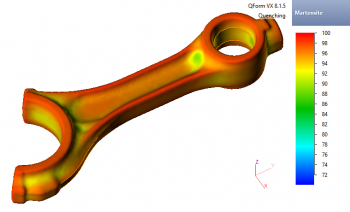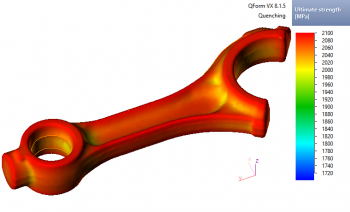Heat Treatment
 Heat treatment simulation of connecting rod in QForm. Hardness after quenchingMost of the technologies for the production of forged parts are required heat treatment after deformation to obtain the desired properties, both on the surface and through the entire volume of the detail.
Heat treatment simulation of connecting rod in QForm. Hardness after quenchingMost of the technologies for the production of forged parts are required heat treatment after deformation to obtain the desired properties, both on the surface and through the entire volume of the detail.
The heat treatment module is intended for predicting of the properties, such as hardness, ultimate strength, phase composition, stress state and the final shape of the detail.
Many forged parts are complex-shaped and characterized by high thickness difference. The distortion or even failure may occur after their heat treatment due to thermal elastic-plastic stresses appearing due to non-uniform thermal shrinkage and heterogeneous phase composition, as well as the presence of residual stresses after forging operation.
Simulation of heat treatment in the QForm software makes it possible to estimate thermal stresses and distortion at the heating and cooling of a detail, which allows assessing the probability of cracking and more accurate determining the final shape of forged piece.
Advantages
- Fast simulation of various heat treatment variants to optimize cooling and heating conditions of a detail in order to ensure the required properties, minimization of distortion and heat treatment time, energy-efficient production.
- Determination of the phase composition of detail.
- Prediction of properties of finished forged pieces after heat treatment (hardness, ultimate strength)
- Evaluation of residual stresses and distortion after the heat treatment.
- Quenching cracks prediction option.
 Heat treatment simulation of connecting rod in QForm. Martensite distribution after quenching
Heat treatment simulation of connecting rod in QForm. Martensite distribution after quenching Heat treatment simulation of connecting rod in QForm. Ultimate strength after quenching
Heat treatment simulation of connecting rod in QForm. Ultimate strength after quenching
Special QForm features that help simulate heat treatment:
- Prediction of phase transformations, phase composition of the workpiece, both at the deformation and heat treatment processes.
- Simulation options for diffusion and martensitic phase transformations at cooling and heating of material while accounting the latent heat of phase transitions and volume changes in the transformation process.
- The heat treatment module may be implemented for simulation of different production processes: quenching, tempering, annealing etc.
- Simulation of phase transformations by using the following models: JMAK, Leblond & Devaux, Koistinen & Marburger, as well as custom models developed in Lua.
- Direct interface with the JMatPro software to export material models to the QForm software.
- A special type of boundary conditions for spray quenching simulation.




